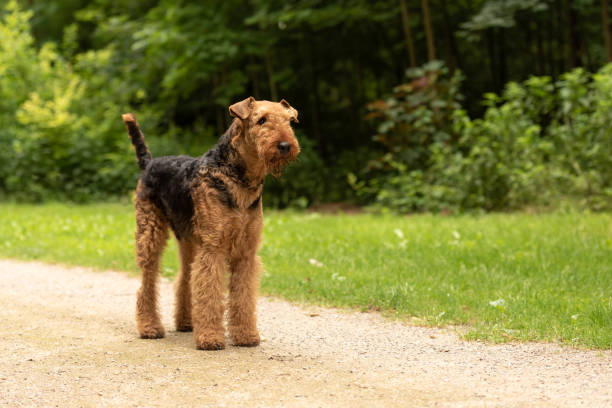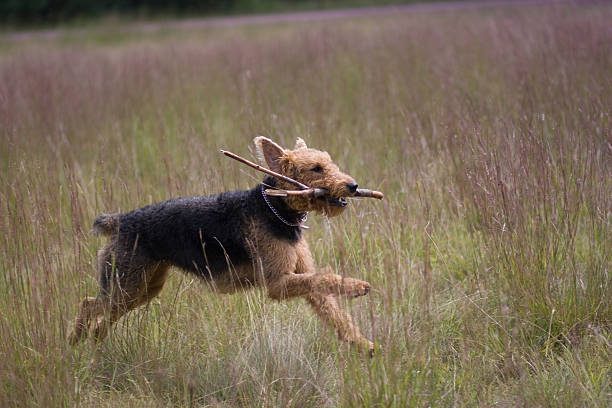Airedale Terrier

Breed History:
The Airedale Terrier, often referred to as the "King of Terriers," is the largest of all terrier breeds. It originated in the Airedale Valley of Yorkshire, England, during the mid-19th century. Originally bred by working-class people to catch rats and otters in the Aire and Wharfe Rivers, the Airedale was developed by crossing Otterhounds with smaller terriers such as the now-extinct Old English Black and Tan Terrier.
Over time, the breed was refined into a versatile, intelligent, and courageous dog used for hunting, guarding, and police work. During World War I, Airedales served as messenger dogs, sentries, and Red Cross aides, cementing their reputation as brave and loyal working dogs. Today, they are cherished both as energetic family companions and capable working dogs.
|
Gender |
Height |
Weight |
|
Male |
58-61 cm |
23-29 kg |
|
Female |
56-59 cm |
18-20 kg |
Size – Medium to Large
Life Expectancy: 11–14 years

Breed Appearance:
The Airedale Terrier has a strong, athletic build with a long, flat head, straight back, and muscular frame. Its dense double coat consists of a hard, wiry outer layer and a softer undercoat. The breed is typically tan with a black (or grizzled) saddle, though some may have slight variations in shading.
It has a long, straight muzzle with a beard and moustache that give it a dignified and slightly comical appearance. The ears are V-shaped and folded, and its dark, expressive eyes convey alertness and intelligence. The tail is usually carried high and may be docked in some countries.
Breed Type – Working/Terrier:
Originally bred for vermin control and hunting, the Airedale Terrier is a classic working terrier that excels in many modern roles, from police work to agility. It is brave, outgoing, and independent, often showing both protective instincts and a playful side.
Airedales are known for their confidence and fearlessness, but also for their devotion to their families. They’re great for active homes that can appreciate their sharp minds and energetic nature.

Training:
The Airedale is highly intelligent, but also independent and strong-willed. It responds best to firm, consistent, and positive training, with plenty of variation to avoid boredom. This breed excels in obedience, agility, tracking, and even protection sports, provided training starts early.
Airedales can be mischievous and stubborn if not mentally challenged, but they thrive under confident leadership. Early socialisation is essential to manage their natural assertiveness with other dogs.
Health & Care:
Generally healthy, the Airedale Terrier may still be prone to certain conditions:
-
Hip dysplasia
-
Allergies and skin conditions
-
Hypothyroidis
-
Gastric torsion (bloat)
-
Eye issues (e.g., cataracts)
Routine vet checkups, a quality diet, and regular activity help maintain good health. Responsible breeders screen for common inherited issues.

Living Conditions:
The Airedale Terrier is adaptable but best suited to homes with a yard or access to open space. It can live in apartments if sufficiently exercised, but thrives in more active, spacious environments.
Airedales need daily engagement, both physical and mental. They do not do well if left alone for long periods and may become bored or destructive without proper outlets for their energy and curiosity.
Exercise:
This is a high-energy breed requiring at least 1 to 2 hours of activity per day. Walks, fetch, hiking, agility courses, and obedience drills are all great for keeping an Airedale happy.
They enjoy both structured exercise and free play and benefit from having tasks or games that challenge their minds. Without enough stimulation, they may dig, chew, or bark excessively.
Grooming:
The Airedale’s wiry coat requires regular grooming to stay in shape. Brushing 2–3 times per week prevents matting and removes dirt. Hand-stripping (plucking dead hairs) is ideal for maintaining coat texture, especially for show dogs.
Bathing is needed only occasionally, as their coats repel dirt fairly well. Regular nail trims, ear checks, and dental care round out the grooming routine.

Advantages:
-
Intelligent and highly trainable
-
Versatile working and sporting breed
-
Loyal and protective with family
-
Adaptable to various activities and roles
-
Low shedding coat (if properly maintained)
-
Bold personality with a fun-loving nature
Disadvantages:
-
Needs plenty of exercise and mental stimulation
-
Can be stubborn and independent
-
Requires regular grooming and coat maintenance
-
May be assertive or dominant with other dogs
-
Not ideal for first-time dog owners
-
Can become destructive if bored or under-stimulated

